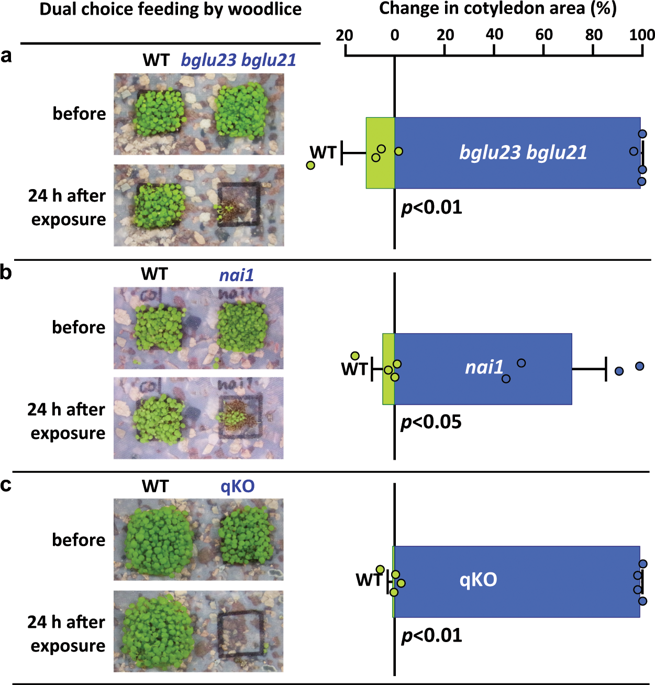当前位置:
X-MOL 学术
›
Commun. Biol.
›
论文详情
Our official English website, www.x-mol.net, welcomes your
feedback! (Note: you will need to create a separate account there.)
Endoplasmic reticulum-derived bodies enable a single-cell chemical defense in Brassicaceae plants.
Communications Biology ( IF 5.2 ) Pub Date : 2020-01-14 , DOI: 10.1038/s42003-019-0739-1 Kenji Yamada 1, 2, 3 , Shino Goto-Yamada 1, 2, 3 , Akiko Nakazaki 3 , Tadashi Kunieda 3, 4, 5 , Keiko Kuwata 6 , Atsushi J Nagano 7 , Mikio Nishimura 2, 4 , Ikuko Hara-Nishimura 3, 4
Communications Biology ( IF 5.2 ) Pub Date : 2020-01-14 , DOI: 10.1038/s42003-019-0739-1 Kenji Yamada 1, 2, 3 , Shino Goto-Yamada 1, 2, 3 , Akiko Nakazaki 3 , Tadashi Kunieda 3, 4, 5 , Keiko Kuwata 6 , Atsushi J Nagano 7 , Mikio Nishimura 2, 4 , Ikuko Hara-Nishimura 3, 4
Affiliation

|
Brassicaceae plants have a dual-cell type of chemical defense against herbivory. Here, we show a novel single-cell defense involving endoplasmic reticulum (ER)-derived organelles (ER bodies) and the vacuoles. We identify various glucosinolates as endogenous substrates of the ER-body β-glucosidases BGLU23 and BGLU21. Woodlice strongly prefer to eat seedlings of bglu23 bglu21 or a glucosinolate-deficient mutant over wild-type seedlings, confirming that the β-glucosidases have a role in chemical defense: production of toxic compounds upon organellar damage. Deficiency of the Brassicaceae-specific protein NAI2 prevents ER-body formation, which results in a loss of BGLU23 and a loss of resistance to woodlice. Hence, NAI2 that interacts with BGLU23 is essential for sequestering BGLU23 in ER bodies and preventing its degradation. Artificial expression of NAI2 and BGLU23 in non-Brassicaceae plants results in the formation of ER bodies, indicating that acquisition of NAI2 by Brassicaceae plants is a key step in developing their single-cell defense system.
中文翻译:

内质网衍生的实体可以在十字花科植物中实现单细胞化学防御。
十字花科植物具有对草食动物的化学防御的双细胞类型。在这里,我们显示涉及内质网(ER)衍生的细胞器(ER体)和液泡的新型单细胞防御。我们确定了各种芥子油苷作为ER体β-葡萄糖苷酶BGLU23和BGLU21的内源性底物。Woodlice强烈喜欢吃bglu23 bglu21或缺少芥子油苷的突变体的幼苗,而不是野生型幼苗,这证实了β-葡糖苷酶在化学防御中具有作用:在细胞器受损时产生有毒化合物。十字花科特异性蛋白NAI2的缺乏会阻止ER体的形成,从而导致BGLU23的丧失和对木虱的抵抗力的丧失。因此,与BGLU23相互作用的NAI2对于将BGLU23隔离在ER体内并防止其降解至关重要。
更新日期:2020-01-14
中文翻译:

内质网衍生的实体可以在十字花科植物中实现单细胞化学防御。
十字花科植物具有对草食动物的化学防御的双细胞类型。在这里,我们显示涉及内质网(ER)衍生的细胞器(ER体)和液泡的新型单细胞防御。我们确定了各种芥子油苷作为ER体β-葡萄糖苷酶BGLU23和BGLU21的内源性底物。Woodlice强烈喜欢吃bglu23 bglu21或缺少芥子油苷的突变体的幼苗,而不是野生型幼苗,这证实了β-葡糖苷酶在化学防御中具有作用:在细胞器受损时产生有毒化合物。十字花科特异性蛋白NAI2的缺乏会阻止ER体的形成,从而导致BGLU23的丧失和对木虱的抵抗力的丧失。因此,与BGLU23相互作用的NAI2对于将BGLU23隔离在ER体内并防止其降解至关重要。











































 京公网安备 11010802027423号
京公网安备 11010802027423号